THE OLYMPIAN & PARALYMPIAN































U.S. Olympians and Paralympians Association President

Dear Olympians and Paralympians,
As winter fast approaches, it occurs to me that the season is not the only thing changing. Here at USOPA, we too are making changes.
Before we look to the future, let us first honor the past. The first seeds of an Olympic alumni association were laid in 1945 at the Philadelphia Bellview-Stratford Hotel, where Jack Kelly (rowing ’20, ’24) and his doubles partner Paul Costello (rowing ’20, ’24, ’28) and his doubles partner Paul Costello (Rowing ’20, ’24, ’28) hosted a gathering of Olympians. This reunion welcomed Olympians of all years while featuring the teammates of the 1920-24 Games.
A year later, the United States Olympic Athletes association was founded in a meeting at the New York Athletic Club. Within a year, the US Olympic Association, objected to the name “Olympic Athletes,” and we changed our name to the United States Olympians Association (USOA). In 2013, we welcomed Paralympians into our ranks and became the United States Olympians & Paralympians Association, or USOPA, as we’re now known.
Between 1946 and 1980, many of our members founded chapters around the country, but leadership at the top level languished. Finally, a group led by Dorothy Franey Langkop (and including Bill Toomey, Jack Elder, Ray Lumpp, Bob Paul, John Krimsky and Edgar J. House) began efforts to rejuvenate the national organization.
Since then, we’ve had a number of dedicated presidents (Bill Toomey, John Naber, Willie Banks, Gary Hall, Sr. and Dick Fosbury) and, starting in 1995, staff too (Danielle Wilkshire, Cindy Stinger, and Christine Taylor). Through the hard work of this group, assisted by vice presidents and chapter presidents, the organization has thrived in its current leadership structure for more than three decades.
And now here we are, feeling the winds of change blowing once again. In the past year, the Executive Committee has taken stock of where we are and where we hope to go in the coming years, and we have concluded that USOPA has outgrown its current leadership structure.
Last month, the Executive Committee submitted a reorganization proposal to Sarah Hirshland. Our proposal is based on best practices we observed in university alumni associations. It features a revised reporting structure that simultaneously allows USOPA more autonomy from and enables greater collaboration with the USOPC. It also requests additional staff and other resources to engage with and provide value to our members so that we, in turn, can help build equity in the USOPC.
In making this proposal, we are asking the USOPC to recognize that you—our Olympic and Paralympic athletes—are its greatest asset, and therefore worthy of significant investment. If you agree with this statement, I encourage you to show your support in whatever way you can—in emails to USOPC leadership, on social media, and through your local chapters. Together, we will make positive changes! Yours
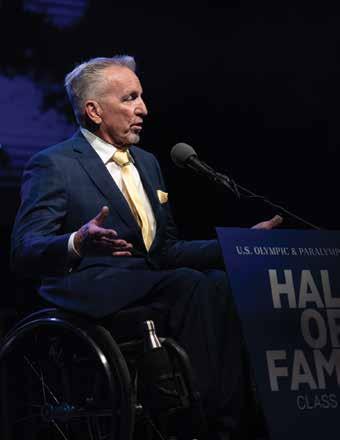
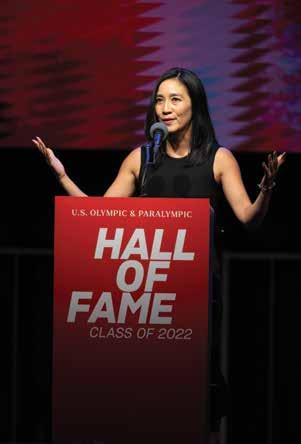

Michelle Kwan speaks during the 2022 U.S. Olympic & Paralympic Committee Hall Of Fame Ceremony on June 24, 2022 in Colorado Springs, Colo.
Michelle Kwan recalled being a 7-yearold watching Brian Boitano land his signature triple lutz during the Olympic Winter Games Calgary 1988, turning to her parents and making a declaration.
“I know what I want to do for the rest of my life,” Kwan told them. “I want to go to the Olympics!”
Rather than laughing at their daughter, her parents explained how much hard work it took to reach the Games.
“And that is where it all began,” Kwan
said. “My parents were the first to believe in me.”
Kwan shared that memory Friday night during her induction into the U.S. Olympic & Paralympic Hall of Fame in a ceremony at the U.S. Olympic & Paralympic Museum in Colorado Springs, Colorado. The Class of 2022 includes eight individuals, two teams, two legends, one coach and one special contributor.
In addition to Kwan, the inductees include: Natalie Coughlin, swimming; Muffy Davis, Para alpine skiing and Para-cycling; Mia Hamm, soccer; David Kiley, Para alpine skiing, Para track and field, and wheelchair basketball; Michael Phelps, swimming; Lindsey Vonn, alpine skiing; Trischa Zorn-Hudson, Para swimming; the 1976 women’s 4x100 freestyle relay swimming team; the 2002
Paralympic sled hockey team; Gretchen Fraser, legend, alpine skiing; Roger Kingdom, legend, track and field; Pat Summitt, coach, basketball; and Billie Jean King, special contributor.
This 17th class of inductees has represented the U.S. as athletes at a combined 27 Olympic and Paralympic Games, producing 129 medals, including 86 gold medals. Summitt and King become the first female inductees in the coach and special contributor categories, respectively.
More than 432,000 votes were cast for this class by Olympians and Paralympians, members of the U.S. Olympic and Paralympic family, and an online vote open to fans. The Hall of Fame now includes 168 individual and team inductees.
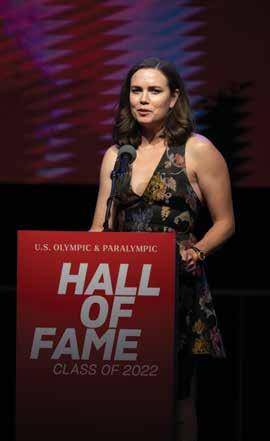



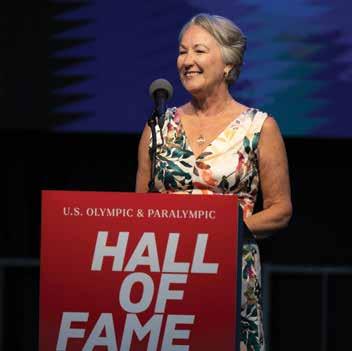
Kwan, the most decorated figure skater in U.S. history, is a two-time Olympic medalist, five-time world champion and nine-time world championships medalist.
“I’m so honored to be inducted into the Hall of Fame,” Kwan said. “And never in my wildest dreams could I imagine being inducted alongside a class of pioneers, giants and GOATS — not literally goats, but greatest-of-all-time Olympic and Paralympic athletes.”
Kwan pointed to the many individuals and organizations who helped make that

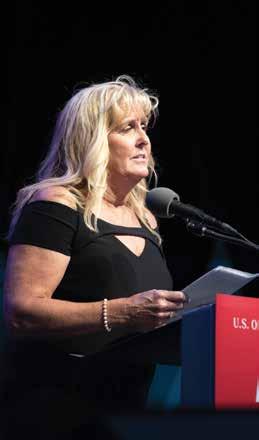

dream come true. The journey was well worth it.
“The Olympics has taught me so many life lessons — hard work, perseverance and never giving up,” Kwan said. “The Olympic ideals are what guide me throughout my life, and I will be forever grateful for the honor to compete at the Olympics and represent the United States of America.”
Vonn owns three Olympic medals, eight world championships medals and a women’s record 82 world cup victories.
“I’d like to encourage past, present and future Olympians and Paralympians to continue to keep the Olympic and Paralympic spirit alive by using your platform for good,” Vonn said. “Like these amazing people before me, and many others have proven, great things can be achieved in ways that reach far beyond the medals.”
Kiley, a six-time Paralympian who won medals in three sports — wheelchair basketball, track and field, and Para alpine skiing — expressed his gratitude for being chosen.
“This is the hall of halls,” Kiley said. “The best athletes in the world live under this roof, and I am one of them. I am in heaven.
“To the USOPC, thank you for integrating the ‘P’ into the acronym of inclusion — USOPC. It was never about what I lost as an adaptive athlete but was always about what I gained.”
The 2002 U.S. sled hockey team brought home the first gold medal for the program and paved the way for future success in the sport. The Americans have won five gold medals in sled hockey, including the last four in a row.
“We did it boys! Heck of way to reunite after 20 years, huh?” said goalie Manny Guerra, speaking on behalf of his
teammates. “What a class of Olympic and Paralympic icons to be honored and inducted with. Surreal.”
Guerra recognized the sacrifices made by the players’ families.
“To our brothers and sisters and our parents, in particular our mothers, who had to put up with us … we say thank you,” Guerra said. “To our partners, sons and daughters, we realize that our own miracle on ice 20 years ago came with a cost, the cost of time away from you. We will forever be in your debt and want you to know how much your support and love means to us.”
Coughlin’s 12 medals in 12 races across three Summer Games tie her with Jenny Thompson and Dara Torres as the mostdecorated women swimmers in Olympic history.
“I look back on my career with such gratitude and pride,” Coughlin said.



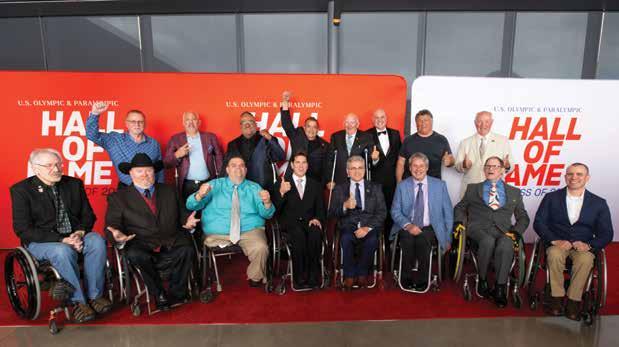
“While I got my fill of competition, I miss the daily grind of chasing impossible dreams with my teammates. That camaraderie is so incredibly special.”
Davis, a Paralympic medalist in alpine skiing and cycling, has continued to promote Para sports.
“An athlete, when they stand, or sit, on top of the podium, is never there alone,” Davis said. “While they may be the one to reap the glory of the win, they couldn’t have done it without the immense support system, foundation, under them.”


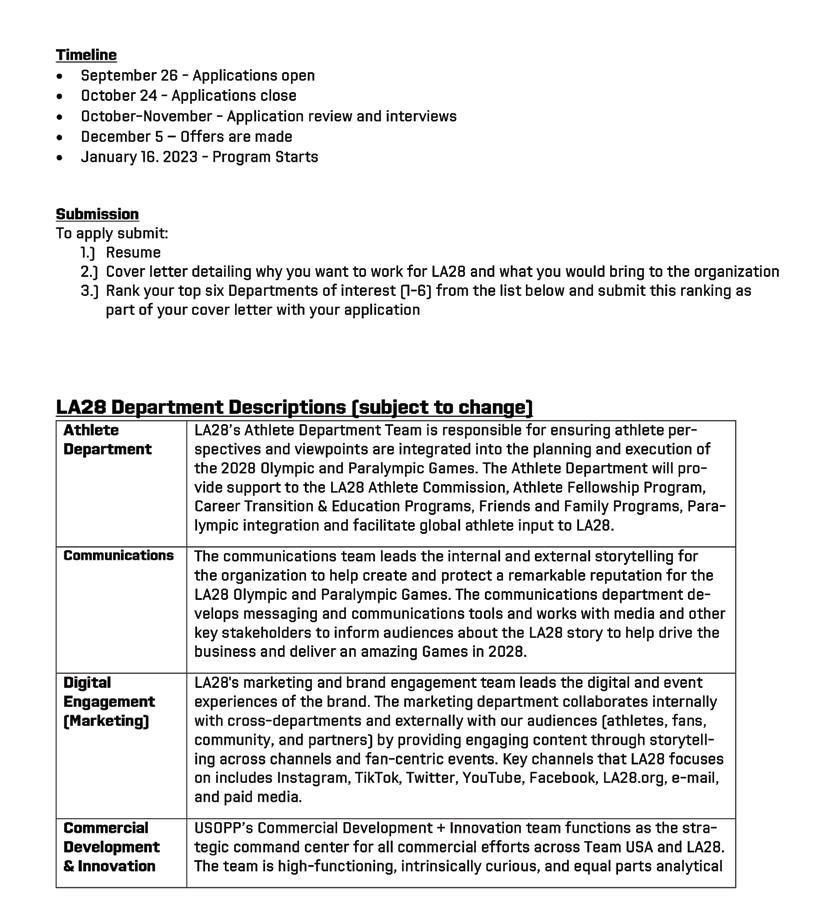





While attending the recent U.S. Olympic & Paralympic Assembly I took advantage of some free time to tour the new museum and visit with staff and the donations of my “Olympic stuff.” To my surprise the red, white and blue warmup outfit worn only by the 1972 luge team has garnered a lot of attention. The blue leather gloves with red and white trim have, if you look closely, been well loved. The camera case and Kodak Instamatic with film was supplied to the entire 1972 Winter Olympic Games contingent but strangely was banned from our march into Makomanai speedskating stadium for Opening Ceremony.
I strongly encourage all Olympians and Paralympians to take the time when in Colorado Springs to see the stories that are told of Olympic and Paralympic athletes and our heroes. The staff is warm and welcoming, and they have a surprise for every participant who visits.
Most importantly start making a plan for your “Olympic and Paralympic stuff” to donate to your favorite school, institution or museum.
I strongly encourage all Olympians and Paralympians to take the time when in Colorado Springs to see the stories that are told of Olympic and Paralympic athletes and our hero’s. The staff is warm and welcoming and they have a surprise for every participant who visits.
Most importantly start making a plan for “your Olympic and Paralympic stuff” to donate to your favorite school, institution or museum.

Jack poses with his warm up-uniform on display at the USOPM and it was a classic 1970’s Olympic Games fashion, splashy and loud, made of polyester with snaps on the jacket. They were made by Liberty Bell, the clothing subsidiary of Bonnie Bell, which made skin care products for skiers.
Jack’s Olympic Kodak camera was an Instamatic X-30 and was the official camera of the 1972 U.S. Olympic Team and while it retailed for $38.00, each athlete got one that came with a patriotic carrying case designed by luge coach Fred Hushla.
Jack’s first luge race came at the 1965 World Championships. At the 1972 Sapporo Games, he competed wearing gloves that, unlike today’s did not have metal fingertip spikes. The gloves shown were gifted to the entire Winter Games delegation and belonged to Jack.

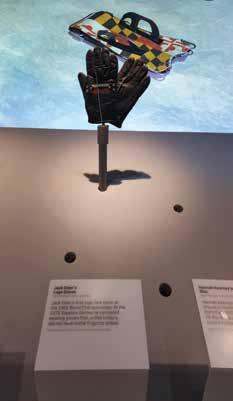
VULCAN PARK AND MUSEUM AND THE WORLD GAMES 2022 WERE PROUD TO HOST BIRMINGHAM’S OLYMPIC & PARALYMPIC DAY
Alabama Olympians and Paralympians met over 100 children in 2nd – 6th grades.
Vulcan Park and Museum and The World Games 2022 were proud to host Birmingham’s Olympic Day when Olympic values of Excellence, Friendship, and Respect and Paralympic values of Determination, Equality, Inspiration and Courage were shared with children from the Jefferson County Boys and Girls Clubs in Brookside, Clay-Chalkville, Hueytown and Warrior. A group of Alabama Olympians and Paralympians were on hand as well as The World Games 2022 mascots.
OLYMPIANS:
Jennifer Chandler, 1976 gold medalist, 3-meter springboard, diving
Mark Everett, Olympian, 1988, 1992, 2000, track and field
Lillie Leatherwood, 1984 gold medalist, 4x100-meters, track and field
PARALYMPIANS:
Bryan Kirkland, 2008, 2000 gold medalist, 2004 bronze medalist, wheelchair rugby
Bob Lujano, 2004 bronze medalist, wheelchair rugby
Jennifer Schuble, 2008, 2012, 2016 gold, silver, bronze medalist, road and track cycling
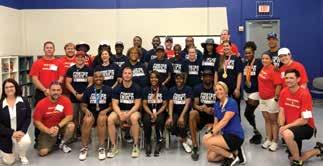
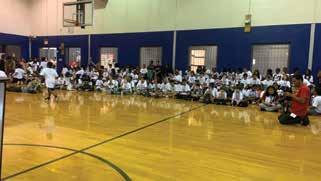
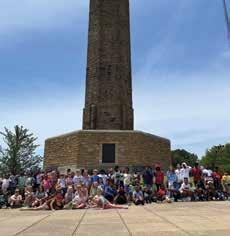


Olympians, Paralympians and volunteers
Q & A session with youth.
The autograph session.

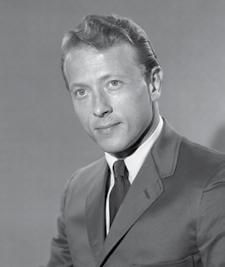
Isaac “Ike” Berger (weightlifting, 1956, 1960, 1964)
Isaac “Ike” Berger died on June 4, 2022, at the age of 85.
Ike was the first featherweight in history to combine lift more than 800 pounds spread over two different lifts - even as his bodyweight never surpassed 60 kilograms, or about 132 pounds.
Born in 1936 in British Mandatory Palestine, Ike was raised by a Hasidic family in the Beit Yisrael neighborhood of Jerusalem. His father was a rabbi. Ike and his family moved to the United States in 1949, and he became a citizen six years later. Then his athletic career took off.
In the ensuing decade, Ike would go on to become one of the most decorated featherweights in U.S. history. He competed in the Olympic Games Melbourne 1956, Olympic Games Rome 1960, and Olympic Games Tokyo 1964. He won gold in 1956 and silver in both 1960 and 1964.
At the 1957 Maccabiah Games, Ike was the first athlete to break a world record
in any sport in Israel. His gold medal was presented by Israeli Prime Minister David Ben Gurion, who called Ike the “gibor Yehudi,” or “mighty Jew.”
The featherweight competed in six world championships between 1957 and 1964, twice winning gold. He also won two Pan American Games and was inducted into the U.S. Weightlifting Hall of Fame in 1965 and the International Jewish Sports Hall of Fame in 1980.
Ike is survived by one sister, two brothers and 13 nieces and nephews.

Hobart “Hobie” Billingsley (diving coach, 1968, 1972)
Hobart “Hobie” Billingsley died on July 16, 2022, at the age of 95.
A loving father, grandfather, veteran, coach, and mentor to many, Hobie leaves behind a legacy of faith, childlike humor, and an unwavering ability to inspire all who met him. As a world-renowned diving coach, Hobie challenged hundreds of divers to realize their full potential, both on and off the diving board.
Hobie was born in Erie, Pennsylvania, to James H. Billingsley and Wenonah Willing Billingsley. He found his passion for diving early in his life, finishing third in the high school national diving championships in 1943, and winning two NCAA diving titles while studying and diving at Ohio State University in 1945.
Hobie would later serve honorably in Okinawa during WWII in the Army Air Corp. Following the war, Hobie returned to Ohio State and received a Bachelor of Science in physical education in 1951. In 1953 he earned a master’s in physical education from the University of Washington in Seattle. Hobie married Mary Drake in 1952, and they had three children.
In 1959 Hobie became the first Indiana University diving coach. While at IU, Hobie led his divers to win six NCAA championships and 23 Big Ten titles. His distinctive scientific approach to diving practices using Newton’s Laws of Motion, previously unheard of in the sport, solidified Hobie’s position as the respected authority in competition diving. As the diving coach for six Olympic diving teams, including the 1968 and 1972 U.S. Olympic diving teams, Hobie’s divers won 132 major titles and seven Olympic medals. Nearly all his divers remained loyal, life-long friends who loved to stage reunions with their old coach, frequently returning to Bloomington from all around the world. Those that knew Hobie know he truly cared for and loved all his divers and students.

Hobie founded the World Diving Coaches Association and was admitted to several athletic halls of fame, including the International Swimming Hall of Fame and the IU Athletics Hall of Fame. He considered being chosen to recite the Judges Oath at the Olympic Games Atlanta 1996 one of his greatest honors, while serving as an Olympic judge.
Hobie attended Bloomington Free Methodist Church, and First Church of God in Bedford where he was baptized in Christ. He had a deep faith in God and was always grateful for the gifts, opportunities, and protection the Lord provides.
Survivors include his two daughters, Nancy (Bruce McConnell) Farmer and Elizabeth (Scott) Bender; a son, Jim (Teresa) Billingsley; eight grandchildren, Carly (Justin) Vest, Lindsey Farmer, Kyle (Kaitlyn) Huttenlocker, Shaun Huttenlocker, Amber Kay, Cory Clarke, Cody Billingsley, Savannah (Joseph) Curry and Lizzie Billingsley; nine great grandchildren, Meleah Vest, Caden Huttenlocker, Carson Huttenlocker, Callahan Litwin, Anna Kay, Jackson Kay, Sadie Kay, Penelope Clarke and Quinn Clarke; his caretaker, Joyce Gray; two nieces, and a nephew. He was preceded in death by his parents, a brother, James Billingsley, and his partner in love Ellender Lee, whose family Hobie remained close with.
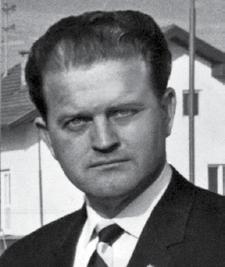
Volley “Bob” Cole (luge, 1964)
Volley “Bob” Cole died on May 12, 2022, at the age of 90.
Bob joined the Army at the age of 14. He was in the Army for 30 years serving in the Korean War and Vietnam War. Highly decorated, he retired as a sergeant major. Bob then went on to work for McDonnell Douglas in Saudi Arabia as a contractor where he worked for 10 years.
With all his accomplishments, Bob and his teammates competed on the first American luge team competition at the Olympic Games Innsbruck 1964. Along with coaching and teaching, he remained a part of the Olympic Movement and traveled all over the world.
After full retirement he and his wife Mary settled in Phoenix, Arizona, where they resided for 30 years purchasing many beautiful homes in the Sun Lake area enjoying golf and friends.
Bob is survived by Mary, to whom he was married for 48 years. He also leaves behind his sister, and a lengthy
list of children, grandchildren, great grandchildren, and stepchildren.

Paul Coppo (ice hockey, 1964)
Paul Coppo died on June 2, 2022, at the age of 83.
Paul was a 1956 graduate of Hancock High School. He furthered his education at Michigan Tech University in Houghton, Michigan, and received his bachelor’s degree in mechanical engineering. Paul began his career at Green Bay Drop Forge and then moved onto Green Bay Structural Steel, Wheeling Steel and then became co-owner of Upper Lakes Coal and Fox River Dock.
Paul was an exceptional athlete, excelling in multiple sports at a young age, but his love for the game of hockey is what drove him to pursue it and become a fierce competitor in the sport. He started his youth career with the Portage Lake Pioneers which led to playing collegiate hockey at Michigan Tech University where he led the team as captain, first team All-American, and leading scorer. After

his college career, Paul made the move in 1960 from his hometown of Hancock, Michigan, to Green Bay, Wisconsin, to play for the Green Bay Bobcats. In his 12-year career as a Bobcat, he scored 227 goals and 325 assists for 557 total points setting the record as the team’s all-time leading scorer. He then went on to become the leading scorer for both the 1962 U.S. National Team and at the Olympic Games Innsbruck 1964.
Following his playing career with the Green Bay Bobcats, Paul then coached the team and later became an owner. He was later inducted into the United States Hockey Hall of Fame in 2004 and the Wisconsin Hockey Hall of Fame in 2006.
Paul felt it important to share his passion for the game and in doing so became involved in the De Pere Youth Hockey Association, where he coached and mentored young players for eight years. After his hockey career, he continued to be a strong supporter of the local ice hockey programs in De Pere and Green Bay, spending countless hours coordinating and contributing to fundraising activities, helping to grow both area’s youth hockey programs as well as the collegiate program at St. Norbert College.
Paul is survived by his daughter and son-in-law: Christine (Gregg) Verbeten; son and daughter-in-law: John (Kristina) Coppo; grandchildren: Lindsay (Christopher), Benjamin (fiancé Ashtin) Verbeten, Grady, Ava, and Casey Coppo; great-grandchildren: MacKenzie, Calvin,
and Henry; one sister and brother-in-law: Kathy (Mike); brothers-in-law and sistersin-law: Sonya Coppo, Gertrude Witting, Jim (Sandy) Witting, Lois Witting, John (Peg), and Bruce Witting; special friend: Nona Ruohonen; nieces, nephews, other relatives and friends. Paul was preceded in death by his parents: Paul and Emma Coppo; wife of 48 years: Carol Jean; sister and brother-in-law: Marilyn (Edward) Santori; brother: Michael Coppo; father and mother-in-law: John (Mary) Witting; brothers-in-law: Jocho Witting, Al Witting, and George Witting; and nephew: Chad Witting.
Always quick with a joke and the best punchlines ever, Paul will always be remembered for his laughter and generous heart.

Winthrop “Wink” Davenport (volleyball, 1968)
Winthrop “Wink” Davenport died on May 3, 2022, at the age of 80.
Wink began playing volleyball in the late 1950s at the Binghamton, New York, YMCA. After playing basketball and golf at Wesleyan University, he graduated and
moved to California where he earned a spot on the U.S. Men’s National Team. He won gold with the team at the Pan American Games Winnipeg 1967. Wink helped the squad win four matches, including a 3-2 win over the Soviet Union, which went on to win the gold at the Olympic Games Mexico City 1968.
Wink also competed in the 1969 FIVB World Cup before retiring in 1971. Before the end of his career, he captained Santa Monica’s USVBA club team to a national title and earned All-America honors.
He didn’t leave the game after he stopped playing. He earned national certification as a referee in 1970, starting a longer and more illustrious career as an official. He officiated at world junior championships, world cup, world championships and the Olympic Games Seoul 1988, not to mention several NCAA men’s and women’s championship matches.
Wink also was involved in volleyball at the administrative level, serving on the U.S. Volleyball Association (the precursor to USA Volleyball) board from 1971-77 and as the organization’s vice president from 1973-76. Internationally, he was secretary of the International Federation of Volleyball Officials and was referee delegate at the Olympic Games Atlanta 1996.
Wink’s lengthy service to volleyball has been widely recognized. In 1986, he was one of the USA Volleyball’s inaugural Glen G. Davies Referee Service Award

winners. A decade later, he received the Wilbur H. Peck Referee – Emeritus Award, USAV’s top award for officials. After another 12 years, he received the James E. Colman USA National Team Award for his “unusual performance of excellence and uncompromising commitment to the USA national team programs.”
He’s been inducted into the Southern California Indoor Volleyball Hall of Fame and Wesleyan University Athletics’ Hall of Fame.
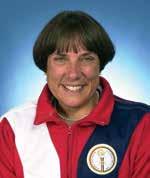
(Para-equestrian, 1996, 2000)
Hope C. Hand died on June 12, 2022, at the age of 73.
Hope is the pioneering and inspirational founder, president, and executive director of the U.S. Para-Equestrian Association, a two-time U.S. Paralympian, and longtime corporate tax auditor for the Internal Revenue Service.
A rider and animal lover as a child, Hope was instrumental in the rapid increase of disabled American equestrians and their ability to compete in the Paralympic
Games, World Equestrian Games, and other local, national, and international competitions.
A competitor at the Paralympic Games Atlanta 1996 and Paralympic Games Sydney 2000, she ushered Paradressage into mainstream American equestrian organizations in the 1990s, organized fundraising events and public relations and recruitment campaigns, established rider and trainer clinics, attracted sponsors, and founded the U.S. Para-Equestrian Association in 2009.
She was a longtime board member of the U.S. Equestrian Federation, chair and vice chair of the U.S. Dressage Federation’s Para-equestrian sports committee, a member of the Para-dressage technical committee of the International Federation for Equestrian Sports, and a participant on many equestrian advisory councils and panels.
Born with spina bifida, a defect of the spinal cord, and paralyzed from the waist down, Hope was an alternate rider for the U.S. equestrian team at the Paralympic Games Atlanta 1996 and U.S. team captain at the Paralympic Games Sydney 2000, where she finished sixth in mixed dressage. She won gold and bronze medals at the 1997 British Invitational, helped her team win the Bradshaw Challenge Cup at the 1998 USEF Festival of Champions, and earned a bronze medal at the 1999 World Dressage Championships in Denmark.
She won awards for her leadership and was president of the Reins of Life therapeutic riding program in Chester County. In awarding her the 2020 Pegasus Medal of Honor for “outstanding service to horses and the sport,” officials at the U.S. Equestrian Federation called Hope “both ambassador and role model.” Others called her “irreplaceable,” “a para guru” and “the superwoman for Paraequestrian.”
Born in Philadelphia, Hope Kean graduated from Widener Memorial School in 1966 and earned a degree in accounting and mechanical engineering at Temple University in 1974. She began working at the IRS in 1967 and rose to corporate tax auditor by the time she retired in 2009.
She was drawn to fast cars and sports as a child, but her use of crutches or a wheelchair kept her out of most team activities. So, she kayaked, rafted, skied on snow and water with her father, and started riding horses at a stable in Northeast Philadelphia when she was 10.
She met Stan Hand through a mutual friend, and they married in 1981 and had daughter Amy. The couple shared a love of adventure, animals, and the outdoors, and lived in Charlestown and later Newtown Square in Chester County.
Hope was organized, optimistic, and whimsical, often joking about her crutches and wheelchair. She called herself “para normal,” whizzed her young

daughter around the house on her lap in the wheelchair, and later took her family to England, Denmark, Norway, Australia, and elsewhere on equestrian road trips. In addition to her husband and daughter, Hope is survived by two grandchildren, a brother, and other relatives.
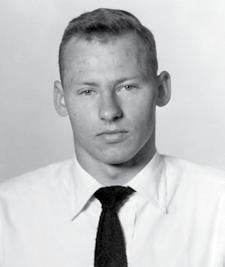
Gerald “Gerry” Holan (swimming, 1952)
Gerald “Gerry” Holan died on July 23, 2022, at the age of 91.
Gerry was born in Westchester, Illinois, to George and Elsie Holan. He was the 1949 National High School Champion in the 100-yard breaststroke, swimming for Proviso Township High School in Maywood, Illinois, and won the national YMCA 200-yard breaststroke championship that year. Gerry was an All-American for the Ohio State Buckeyes in 1951, 1952, and 1953, helping them win the Big Ten 300-yard medley relay all three years.
In 1953 he won the Big Ten 200-yard breaststroke and was NCAA champion in the 200-yard butterfly, before that stroke used a dolphin kick. He also helped
Ohio State win the NCAA titles in the medley relay in 1951 and 1953. Gerry was inducted into the Ohio State Hall of Fame in 1997. He competed at the Olympic Games Helsinki 1952 and set an Olympic record of 2:36.8 in his initial heat. After graduating from Ohio State with a business degree, Gerry began working for Bell Telephone. He left for a tour of duty in the Korean War, as an artillery training officer with the United States Army but returned after the war to work for Bell for his entire business career.
Gerry was a faithful servant of God and an active member of Wheaton Bible Church for 38 years. He is survived by his wife of nearly 66 years, Rose; son, Gerald (Susan) Holan, Jr. with children, Timothy, Jennifer, Amy, and Amanda; son, Jeff (Heidi) Holan with children, Jacob, and Luke; and daughter, Dr. Anna (David) Snider. He was preceded in death by his brother, George, and his parents.
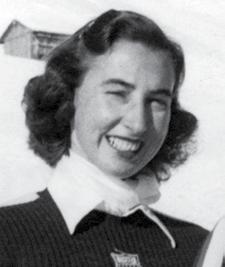
Jannette Burr Johnson (ski and snowboard, 1952)
Jannette Burr Johnson died on July 26, 2022, at the age of 95.
Jannette was introduced to the mountains, snow, and skiing at a very young age. Her father, Wallace Burr, manufactured water skis in Seattle, and the family was a member of the Seattle Mountaineers. After she won the first race at Snoqualmie Pass, she was hooked.
Soon she entered a four-way competition, taking third place and defeating many males in the competition. In 1953, Jannette won the Eccles Cup at Snowbasin and the Brighton Intermountain Giant Slalom and placed second in the Snow Cup.
She was the national downhill champion in 1948 and 1950 and the North American downhill champion in 1950.
In 1951 and 1952 she won several races in Europe. In 1950 and 1954, Jannette was a participant in FIS World Championships in Sweden and a member of Team USA at the Olympic Games Oslo 1952. In 1954 FIS competition in Sweden, when she won the bronze medal in the giant slalom, she was wearing “lucky” stretch pants she had borrowed from storied ski competitor Buddy Werner. She was one of the first women racers to wear stretch pants for cutting wind resistance.
She was the only American to win a medal, a bronze, in the 1954 world championships.
In 1955 she was awarded the Diamond Harriman Pin, an honor shared only with ski legend Gretchen Fraser. In 1970 she was inducted in the National Ski Hall of

Fame and Sun Valley gave her a lifetime free pass.
During the 1960s, she worked as a ski instructor in Sun Valley and gave ski lessons to several members of the Rockefeller and Kennedy families. There was more to Jannette than just snow skiing. In the summer months in Seattle and Florida, she was also performing as a championship water skier using her father’s boards.
In retirement she never sat still. She took up bridge and became a life-master, and ballroom dancing. One highlight of her career was doubling for Lucille Ball in Lucy Goes to Sun Valley, it was one of her most memorable accomplishments that also earned her a broken ankle while finishing the last take.
She leaves a daughter, Kelly Johnson, who lives in Arlington, Washington.

Kenneth “Kenny” Moore (track and field, 1968, 1972)
Kenneth “Kenny” Moore died on May 4, 2022, at the age of 78.
Kenny began running at North Eugene High School and often quoted the wisdom of his coach Bob Newland, although he described himself as “late in maturing” and never won a race in high school. To pay for college, he worked part-time in paper mills. He arrived at the University of Oregon in 1962 as an undistinguished miler who (in his own words) “desperately wanted to be an Oregon runner,” and was logging high training mileage with that purpose.
Coach Bill Bowerman gave him a more balanced program, and by 1966, when he graduated with a degree in philosophy, he was a three-time All American, with national-class PRs for one mile (4:04.2) and the 3,000-meter steeplechase (8:49.4). He was also the first wear-tester for Bowerman’s earliest experimental running shoes. A half century later, Nike honored him with the “Kenny Moore Collection.”
He went on to Stanford Law School with a scholarship. In 1967, he won the AAU National Cross-country Championship, and in 1968 moved to Lake Tahoe to prepare for the Olympic trials. He has written movingly about combining dedicated training with response to the political and racial tensions that split America that year.
At altitude, he placed second in the Olympic marathon trials in 2:31:47, and in the higher altitude at the Olympic Games Mexico City 1968, he was well placed early on, running with defending
champion Abebe Bikila, feeling “amazed and idolatrous” to be alongside his hero. Severe blisters ended the dream, and he struggled painfully to finish 14th in 2:29:49.
Also in 1968, he married Roberta (Bobbie) Conlan, decided against law as a career, and joined the U.S. Army. He benefited from its track program, with the opportunity to compete internationally, backed by stern regulations about being returned to the unit for inadequate performance. Among other major races, Kenny was able to travel twice to the Fukuoka Marathon, informally the annual world championships in that era. He broke the American marathon best there in 1969, running 2:13:28, and in 1970 he ran 2:11:36, placing second.
After two years in the Army, Kenny went back to Oregon and completed an master’s in creative writing in 1972.
Both running and writing then flourished. On the track, Kenny was good enough to place second and fourth in the national six miles or 10,000 meters and won the 1971 U.S. marathon title in a championship record of 2:16:48, earning selection for the Pan Pacific Games. In that same year, he became a contract writer for Sports Illustrated, beginning a 25-year career at the pinnacle of the sports journalism profession.
In 1972, Kenny and his close friend Frank Shorter confidently dead-heated in a U.S. Olympic marathon trials record of 2:15:58.
At the Olympic Games Munich 1972, the marathon was run under the shadow of the terrorist massacre of Israeli athletes. After days of conflict about the appropriateness of competing, Kenny ran, but only a mile into the race, he tripped and fell at a crowded corner. “I curled into a ball until an opening appeared in the slapping feet and was up quickly, with a stinging elbow and knee and a thirtyyard deficit,” he wrote later. He rejoined the leaders in time to witness Frank’s victorious surge. After running equal with the defending champion, Mamo Wolde, in second place, Kenny finished fourth in 2:15:39, proudly part (with Shorter and Jack Bacheler, ninth) of the best threeman team result by any nation to that date.
Kenny’s prime years as a runner could be charted by his unmatched streak of six wins in San Francisco’s Bay to Breakers from 1968 to 1973. He broke the record twice, bringing it down by two minutes. He kept writing supremely well, with insightful profiles of great runners like Roger Bannister and Lasse Viren, which were later collected in the book Best Efforts (1982).
He left Sports Illustrated in 1995 to focus on his greatest written work, the biography and cultural history, Bowerman and the Men of Oregon (2006). Kenny’s combination of personal insight, historical understanding, research, eloquent writing, and sheer intelligence of ideas make it one of the best of all sports biographies, with wider importance in
its treatment of Bowerman’s military service and the history of Nike. It is also in part the reticent Kenny’s concealed autobiography, with its wrenching treatment of the Munich terrorism.
Kenny returned to that significant time in his own life when he led a successful human rights campaign to redress the unjust imprisonment in Ethiopia of Mamo Wolde, who in 1972 had narrowly beaten him for the bronze medal.
With his second wife, Connie, Kenny lived his later years in Hawaii, where he continued to write, including several profiles for Runner’s World. He was inducted into the Oregon and University of Oregon sports halls of fame, and won the George Sheehan, George Hirsch, and RRCA awards for running journalism. His literary mission, he said, was “to make an athlete’s experience understandable to a wider readership.” He achieved that and much more.


Marvin Moriarty died on April 20, 2022, at the age of 85.
Marvin was a skiing legend, a business entrepreneur, and a simple man with incredible talents. He cherished a wide array of friends and relationships. He made friends everywhere he went, yet you always knew where you stood with Marvin. A tennis buddy in Vero Beach referred to him as one of those people that you were glad you met and were able to spend time with. He was indeed a unique individual and human being.
In 1956, at age 17, Marvin became the youngest man ever named to the U.S. Olympic Men’s Ski Team, a record he continues to hold today. This was indeed a stunning accomplishment for a young man from Vermont who made his ski poles from bamboo training gates. Beginning as a junior national champion, he emerged to the prominence of a world class ski racer. There is yet to be another American ski racer who exemplified the determination and talent of Marvin. In 1957 Marvin was named to the 1958 World Championship (FIS) Team. Between 1958 and 1961, he made significant accomplishments throughout North America and Europe, winning prestigious races such as the King’s Slalom in Norway, the White Ribbon Ski Tournament in St. Moritz, and five Kandahar races throughout Europe. During his travels, Marvin wore a ski hat knit by his mother. She produced a hat with a peak on the top versus the typical rounded ski hat. Marvin wore the hat with pride, and his teammates, other racers and ski instructors around the world asked Ma to make them one. This was the beginning of the Moriarty Hat
and Sweater business, which went on to sell hats at Herman’s and L.L. Bean and launched the cottage industry in Vermont where the knitters came weekly to pick up yarn and orders to return to knit them by hand, and later – hand looms – in their homes.
Marvin spent many years in Aspen, Colorado, where, among many other things, he was a builder, a ski and hockey instructor, and he owned The Mad Dog, a famous bar, where many a good time took place in those days in Aspen.
Marvin was a force in everything he undertook, whether it was exceling in any sport, including baseball, hockey and tennis, to hiking Mt. Washington with two cases of beer on his back to sell on the top, to building and flying his own airplane, to operating his Kubota tractor that he loved so dearly, to riding his Harley motorcycles and building his dream home in the mountains in Stowe with the love of his life Beth.
On March 19, 2022, Marvin turned 85 and celebrated his life with a once in a lifetime party of friends and family that will be cherished for years. Marvin was larger than life. He lived big.
Marvin is survived by his soulmate of 46 years, Beth McMahon of Vero Beach, and his beloved daughter, Kimbirly Moriarty, and cherished granddaughters, Desi, and Skyla Moriarty, of New Haven, Connecticut.
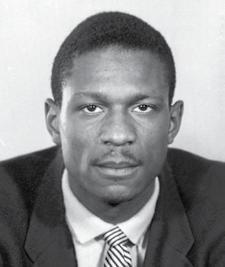

William “Bill” Russell died on July 31, 2022, at the age of 88.
In his 13 seasons in the National Basketball Association with the Boston Celtics, Bill won 11 championships, a record unmatched in team sports. But his place as one of the most influential American athletes of the 20th century is based on more than his implacable will to win, and his intelligence in allying his skills to his teammates to facilitate that process.
He was the NBA’s first black star, five times the league’s most valuable player. His defensive when the Celtics coach Red Auerbach stepped down and named Bill his successor, he became the first Black head coach in modern America’s four major sports leagues.
Off the court, he was a trailblazer in the fight for human dignity. Bill stood beside Dr. Martin Luther King, Jr. during his “I Have a Dream” speech in Washington. When Ali resisted the draft, Bill was next
to him at the “Cleveland summit” of star athletes, with the gridiron star and actor Jim Brown on the other side.
Bill came to his abilities late but learned his sense of self-worth early. He was born in deeply segregated Monroe, Louisiana, and his father, Charlie, taught young Bill what his father had taught him: “A man has to draw a line inside himself he won’t allow any man to cross.”
Bill could not make his high school basketball team until his last year. His only college scholarship offer came from the University of San Francisco, but he developed quickly. USF won consecutive national basketball championships in his junior and senior seasons, losing only one game, and winning 55 in a row. In the 1956 final against Iowa, Bill scored 26 points, had 27 rebounds, and blocked 20 shots. He was the leading scorer on the U.S. Olympic Team that won the gold medal at the Olympic Games Melbourne 1956, winning by an unmatched average of 53.5 points per game.
Meanwhile, Auerbach had traded twostar players to get the second pick in the NBA draft, and the Celtics owner, Walter Brown, persuaded the Rochester Royals to pass on Bill with the first pick, by offering their arena the chance to host a money-spinning two-week run of the Ice Capades in exchange. After the Olympic Games, Bill led the Celtics to the 1957 title, over the St. Louis Hawks. In fact, he could probably have claimed 12 titles in

13 years had he not sprained his ankle in game three of the 1958 finals, also against the Hawks, which the Celtics then lost.
At 6 feet10 inches, Bill possessed agility that changed the way big centers played. He played center like a sweeper; his teammates overplayed opponents, defending tightly, knowing he could cover their mistakes. He controlled his blocks and rebounds to get the ball up court to teammates; the trademark Celtic “fastbreak” offense was born.
Bill co-wrote four books, Second Wind (with Taylor Branch, 1979) and Red and Me (with Alan Steinberg, 2009) are classics of sporting memoir. In later years, his public persona mellowed to match his private one, helping cement his legacy. He was reconciled with Boston, where in 2013 a statue of him was unveiled in City Hall Plaza. The NBA’s trophy for most valuable player in the finals is named after him. In 2012 he was awarded the presidential medal of freedom by Barack Obama. in 2017, when there was a call for NFL players taking a knee to “be fired”, Bill released a video of himself, kneeling, holding that medal.
The NBA will honor Bill by retiring his No. 6 jersey throughout the entire league.
Bill is survived by his fourth wife, Jeanine Fiorito; son Jacob and daughter, Karen, from his first marriage to Rosie Swisher. His older son, William Jr, died in 2016. His second marriage, to Dorothy Anstett, a former Miss USA, ended in divorce. His
third wife, Marilyn Nault, died in 2009.
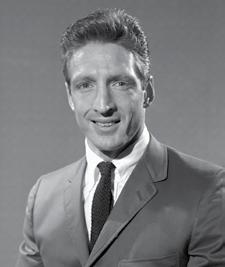
Arthur “Art” Shurlock (gymnastics, 1964)
Arthur “Art” Shurlock died on May 14, 2022, at the age of 84.
After competing in the 1958 world championships, Art became the second University of California, Berkeley gymnast to capture an individual NCAA title in 1959, taking first on the pommel horse, placing second on rings and third on high bar, as well as third in the all-around contest. He also reached All-American status the next two years and went on to become a member of the U.S. National Team, winning the all-around title at the U.S. Gymnastics Federation Championships in 1963. Art placed tenth on pommel horse at the Olympic Games Tokyo 1964 as part of his all-around campaign, then followed that up with a career of over 30 years as head coach for UCLA men’s gymnastics.
At UCLA, Art coached nine Pac10 championship and two NCAA championship teams, as well as 14 individual NCAA champions, 26 All-
Americans and 9 Olympians (all medalists). He earned Pac-10 Coach of the Year honors each year from 198189, as well as NCAA Coach of the Year honors in 1984 and 1987.
In 1985, Art was inducted into the USA Gymnastics Hall of Fame; two years later, Cal Athletics inducted him into its own hall of fame.
Art is survived by his wife Alice and son Mark.

Thomas “T.D.” Smith, III (shooting, 1964)
Thomas “T.D.” Smith, III died on May 7, 2022, at the age of 90.
T.D. was born to Mary and Thomas D. Smith II in Sabinel, Texas. He grew up in San Antonio, Texas. As a young teenager he crossed paths with Ad Toepperwein, a famous exhibition shooter of the 1920s and ‘30s. For several years, Ad taught T.D. the art of pistol shooting. This learning experience sparked T.D.’s lifelong passion for shooting.
T.D. graduated from Alamo Heights

High School and then went on to Abilene Christian University. During his education, he shined as an athlete. He lettered 14 times in football and track and made all-conference twice. ACU named Smith Boulevard in his honor. In 2014, T.D. was inducted into the Abilene Christian University Sports Hall of Fame and awarded ACU’s Lifetime Achievement Award.
In 1953, T.D. enlisted in the United States Air Force and began his illustrious military career. He was promoted 16 times in 17 years. In 1955, T.D. graduated first in his class from USAF Jet Fight Pilot Instructor School and was retained as an Instructor Pilot. He continued to gain ranks and prove himself as a leader. In 1961, he was named captain of the USAF Pistol Team. In 1963, T.D. received the honor of being named the U.S. Jr. Chamber of Commerce USAF Outstanding Young Man. In 1966, T.D. was on a military flight over Greece when the plane he was on exploded. T.D. experienced a free fall of over 5,000 feet and somehow lived to tell the story. His instincts kicked in and he spent the next several days tending to the other injured men while they all waited on a rescue. The heroic acts that he performed in the four days between the crash and being rescued by a SEAL team earned T.D. several military honors.
The spark for shooting that started as a teenager in San Antonio went on to provide T.D. with unimaginable opportunities and experiences. From 1961-65, T.D. won
36 individual state, regional, national, and international pistol championships, breaking 79 National Rifle Association and world shooting records. He was a member of eight United States shooting teams in international competitions, including the 1963 Pan American Games where he won an individual and team gold medal and the Olympic Games Tokyo 1964, where he finished eighth in free pistol. He won five individual national shooting championships. At the 1963 Pan American Games he was shooting at targets the size of silver dollars and the second day at moving targets from 25 meters. He won the gold medal with a score a 597 out of a possible 600, besting the world record of 591 held at the time by a Russian. In 1988, the size of the shooting targets was changed, and T.D.’s world record set in the 1963 Pan American Games is now considered retired, never to be broken.
After his retirement from the Air Force, T.D. moved to Buffalo, Wyoming, and married his second wife, Ann Cusak. Wyoming was a great place for him to enjoy another passion of his, hunting. The game wardens in Wyoming even called on T.D. to help as a shooting teacher. After Ann passed, he moved to Oklahoma City. It was in Oklahoma City that T.D. met the love of his life, Barbara. After three years of dating, he decided it was time to marry. T.D. and Barbara married on Veteran’s Day in 1989. Barbara introduced him to some police officers and hunters and the hunting he loved in Wyoming was off and
running in Oklahoma. T.D. joined the OKC Safari Club, where he served as president for two years. He traveled all over the world to hunt, but for T.D. it was never about the trophies. He made sure that after every hunt, the meat was donated as food to those who desperately needed it. He was preceded in death by his parents, his first wife, Leatha and his second wife, Ann. T.D. is survived by his wife of 32 and a half years, Barbara Smith; his two orange tabby cats, Baby Girl & Farley; stepson, Billy Lee and his spouse Kelly; stepdaughter, Kathy White, Joey Coleman; step grandson, Christopher Perry; his sister, Mitty and spouse Perry Sheets; daughters, Tammy Smith and Amy Smith; adopted sons, Howard, Lee and Mike; stepdaughter, Toni Dunn and spouse Bruce; granddaughter, Aubrey Busah; step grandsons, Travis and Scott Dunn; many nieces, nephews, step grandchildren, step great-grandchildren, family and friends.

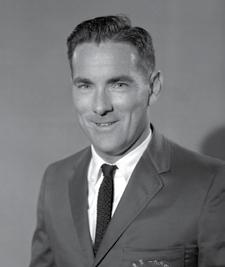
Richard “Dick” Stearns, III (sailing, 1964)
Richard “Dick” Stearns died on January 25, 2022, at the age of 94.
Dick was one of the best sailors to ever come out of the Midwest. He grew up on the south side of Chicago moving to the north side after his father died when he was 16. At 14 years old his father gave him a Star boat to keep him out of mischief. With no formal training or instruction, he went from last place in the fleet and, with Gary Comer, won his first Great Lakes Championship at 17 years old.
Dick attended South Shore High School and Drake University. He bought the sail making company Murphy & Nye from Harry Nye in 1952. The company had made parachutes during the war but was not making sails at the time.
Soon Dick would be making sails for customers around the world, including kings and princes. In 1954, Carlos de Cardenas (from Cuba) won the Star World
Championship with one of the first Orlon sails, which solidified Dick’s company as a leader in the industry.
Dick patented the machine sewn bolt rope. Murphy & Nye also pioneered the cross-cut sail when Orlon and Dacron came out.
Dick’s company would go on to become the dominant force in one-design sails for the next 25 years. Even Lowell North used Murphy & Nye sails prior to starting North Sails. An incredible group of famous sailors worked at Murphy & Nye. At one point Murphy & Nye sails dominated most design classes and all the Olympic sailing classes.
He won eight Star Western Hemisphere Championships, two Star North American Championships, and the 1962 Star World Championship in Portugal with long time crew Lindsey Williams. The next year Dick won a gold medal at the Pan American Games with crew Buck Halperin, and silver at the Olympic Games Tokyo 1964 with crew Lindsey Williams.
Dick’s Olympic contribution didn’t stop with a silver medal. He was the assistant Olympic coach in 1968 and then the Olympic sailing coach in 1972 and 1976. He was the chair of the U.S. Olympic Committee for eight years and coach of the U.S. Pan American Team in 1971 and 1975. He was the vice president of the
United States Yacht Racing Union (now US Sailing).
In the mid-70s, Dick moved on to sailing larger boats. He was one of the cofounders of the Chicago T-10 fleet. In 1978, he won the first of his two T-10 North American Championships. He went on to win multiple Mackinac races with his T-10s Dora and Glider.
In 2000, Dick sailed his 35-year-old Cal 40 to first overall in the Millennium 600 Port Huron to Chicago race, beating boats like the new maxi boat Magnitude, an Andrews 70. Dick sailed 53 Mackinac races, sailing on famous boats Dyna, Dora, Inferno, Bay Bea, as well as his own Cal 40 and T-10s. His last Mac races were sailed on J/Boats with his son Rich and daughter-in-law Lori.
Sailing was not Dicks only love. He flew airplanes before he could drive. From a T-6 and a Navion to multiple Bonanza’s and Cessna 310s, he flew into his 80s. Then he picked up model airplane flying which he continued until his death. He was an honorary member of his remotecontrolled flying club in Richmond, Illinois. He was a skeet shooter his entire life starting in his teens when there were gun clubs on Lake Michigan. Normal scores of 23 to 25 (perfect score) were common for Dick.He was a long-time board member of the Sea Scouts and was a member of Chicago Yacht Club since 1942.

Dick is survived by his partner and special friend Bernice DeWeerd, his sons Richard (Lori), Chris, his daughters Susie (Bill) Allen and Barbie (Dave) Alampi and his eight grandchildren and five great grandchildren.
Dick was a kind, gentle soul and was loved and admired by all.
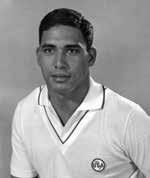
William “Bill” Woolsey (swimming, 1952, 1956)
William “Bill” Woolsey died on June 25, 2022, at the age of 87.
Bill was born in Honolulu. He grew up in Manoa Valley, where a street is named after his family.
He lived on the shoreline and was introduced to the water as soon as he could walk. When he was 5 or 6 years old, he was able to go free-diving and fish with a spear and a sling. By age 8 or 9, he was swimming competitively.
Eventually, he was introduced to Soichi Sakamoto, a schoolteacher and Boy Scout scoutmaster on Maui, who had developed a training program that included swimming against the current of a drainage ditch.
Bill won gold in the 800-meter freestyle relay at the Olympic Games Helsinki 1952. At age 17, he was the youngest member of that swim team.
As a junior in 1956, Bill won Big Ten titles in the 220, 440, and 1,500-yard freestyles. He added NCAA titles in the 220 and 440, helping the Indiana Hoosiers to sixth in team standings. He repeated those NCAA titles in 1957, and Indiana climbed to fourth.
Bill won his second Olympic medal, a silver in the 800-meter freestyle relay, at the Olympic Games Melbourne 1956. His international career continued through the 1959 Pan American Games, where the 24-year-old won a bronze medal in the 100-meter freestyle.
He became a learn-to-swim advocate and was dismayed when he found so many Hawaiian children did not know how to swim. His life’s goal was to teach as many kids as possible to swim because they lived on an island.
Bill’s 10-lesson, Ho’au learn-to-swim
method — Ho’au means “forward in the water” in Hawaiian — taught children in Hawaii and California. He taught swimming into his 70s. He was inducted into the Hawaii Sports Hall of Fame in 1998.
Bill is survived by his wife Julia; daughters Heidi and Kelly; sons Tripp and Cleve; 13 grandchildren; and nine greatgrandchildren.

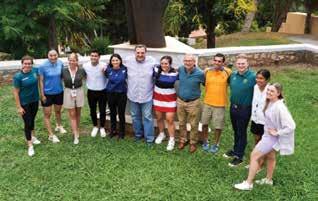
When my plane touched down in Athens, Greece, I had no idea what was in store. Admittedly, I was nervous as I waited to disembark. As the International Olympic Academy’s 62nd Session for Young Olympic Ambassadors began and I met the other 120 attendees, I started to notice a trend: There were no other Paralympians. At first I began to wonder if that meant I didn’t belong here. Maybe I was in the wrong place or with the wrong program. There were Olympians, coaches, researchers, trainers, NOC staff, and everything in between; everything except another Paralympian.
I should have prefaced this by saying that I understand that at the International Olympic Academy that the focus would be on the Olympic Games, but as we move towards equality between the Olympic and Paralympic Movement, it feels important that we are considering the Paralympic Movement in the same spaces where we are discussing the Olympic Movement. On our discussion schedule for the two week period, there were one or two Paralympic-focused

sessions and I was unsure what they would be like.
In talking with my peers, I realized that internationally there seemed to be a general lack of awareness surrounding the Paralympic Movement, even with people who worked in Olympic sport. I had trouble wrapping my mind around the fact that some people were working so closely to the Paralympic Games and still hadn’t truly been exposed to them. I made it a personal goal of mine to reach a few of the other attendees while I was in Olympia, hopefully igniting a passion within them for the Paralympic Movement as well. Throughout the program, I was having productive conversations with my peers and I learned about what elite sport was like in their countries while sharing my outlook on the Paralympic Games with them.
As the program continued and the other attendees realized my passion for the Paralympic Movement and openness to talking about it, I found myself becoming a resource to them. I watched as
Emma Schieck is on stage with fellow gold medalists and IOA professors addressing the attendees of the IOA. In this session, the three gold medalists described their experiences at the Games and answered questions from the audience.
Emma Schieck is pictured with the other athletes who were in attendance at the 62nd Session for Young Olympic Ambassadors alongside the IOA’s president. This photo was taken on the last full day of the session after the athletes had each presented their athletic career to their peers.
Emma Schieck stands with other U.S. delegates Hannah Miller and Bryce Mackinnon at the Acropolis in Athens, Greece before departing for the International Olympic Academy in Olympia, Greece. Prior to the workings of the session, all attendees are given the opportunity to tour some of the historical sites of Athens.
throughout the program, presentations that were once given on the Olympic Games were then being given about the Olympic and Paralympic Games. In group discussions, we were now considering the impact of changes to the Olympic Movement on the Paralympic Games as well. Watching sport-professionals who considered the Paralympic Movement only as an afterthought shift it into a real consideration was one of the most gratifying experiences.
As I write this today, almost two months after leaving the International Olympic Academy, I feel grateful. I am grateful for all of the knowledge that my fellow attendees shared with me. I am grateful that they all were so eager to listen to my story. I am grateful that they were open to hearing about the Paralympic Movement. And most of all, I am grateful for the new Olympic and Paralympic family that I have all across the world.
Emma Schieck, PLY
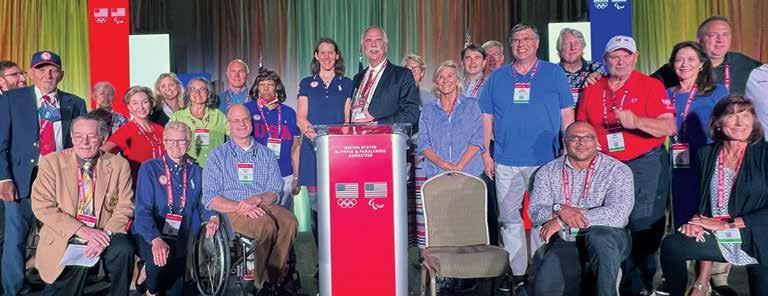




1. USOPA board members gather for the annual Dorothy Franey Langkop Luncheon photo.
2. Caryn Davies, USOPA president, presents the 2022 Dorothy Franey Langkop Ambassador Award to John Naber.
3. John Moffet and John Naber honor the Ready, Set, Gold! Program and present to Michaela Reynolds with the Rings of Gold Program Award.
4. Andy Toro, 2022 Olympic & Paralympic Torch Award winner
5. Melissa Stockwell, 2022 Rings of Gold Award winner
6. Kenny Moore, a two-time Olympic marathon runner who used his deep understanding of athletes to become a pre-eminent track writer at Sports Illustrated for nearly 25 years, died on May 4 at his home in Kailua, Hawaii. He was 78. The Olympic flag was presented to the family of Kenny Moore by fellow Olympian, Keala O’Sullivan (diving, 1968).
Kenny’s wife, Connie accepted the flag who then gifted it to Kenny’s nephew, Christopher. Dan Drown (water polo, 1964) president of the Hawaii Chapter is standing in the background to the left of Keala.
7. Memorial Service was held on May 17, 2022, Beach side on Lanikai Beach, Oahu. Lanikai is where Kenny lived.
8. After the services, standing next to Kenny’s picture, left to right are 3 close friends, and his wife on the far right (orange shorts) – Connie Johnston.
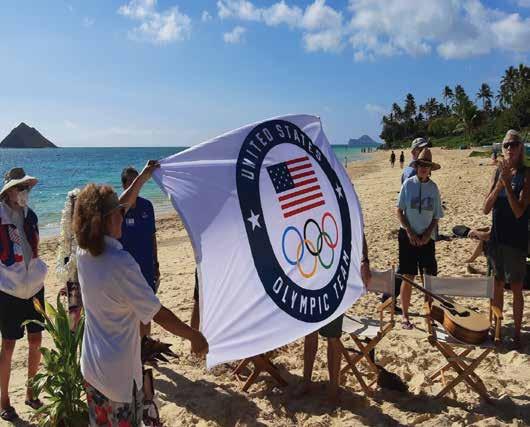
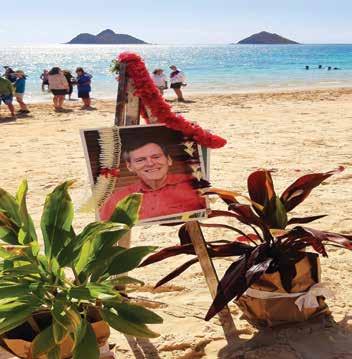


OFFICIAL TEAM USA NETWORK: teamusa.org/Team-USA-Athlete-Services/Alumni
Join our private groups on Facebook and LinkedIn to stay connected.
FACEBOOK:
United States Olympians and Paralympians
1,200 members
LINKEDIN:
United States Olympians and Paralympians (364 members)
Olympic and Paralympic Alumni (12,876 members international)
CONNECT WITH LA 2028:
Youtube: youtube.com/channel/UC0HoUCfNT_13tkuxvtdnyA
Instagram: instagram.com/la2028Games/
Twitter: twitter.com/LA2028
Facebook: facebook.com/la2028/
PRESIDENT
Caryn Davies (Rowing, 2004, 2008, 2012)
Contact: caryn.davies@gmail.com
VICE PRESIDENTS
Bob Balk (Para Skiing, 1994, 1998, 2002, 2006; Para Athletics, 1996, 2000)
Contact: bob.balk@outlook.com
Bruce M. Furniss (Swimming, 1976)
Contact: bfurfam@msn.com
Craig Gilbert (Team Handball, 1984)
Contact: cgilbert1@gmail.com
David Hughes (Sailing, 2016, 2020)
Contact: hughes470@gmail.com
Sharon A. Jewell (Taekwondo, 1988)
Contact: neolympianparalympian@gmail.com
John C. Moffet (Swimming, 1980, 1984)
Contact: john.moffet@olympian.org
Lydia R. Murphy-Stephans (Long Track Speedskating, 1984)
Contact: lydiastephans@gmail.com
IMMEDIATE PAST PRESIDENT
Dick Fosbury (Track and Field, 1968)
Contact: rfosbury68@gmail.com
PAST PRESIDENTS
Gary Hall Sr. (Swimming, 1968, 1972, 1976)
Contact: garyhallsr@mac.com
Willie Banks (Track and Field, 1980, 1984, 1988)
Contact: bankshw@hotmail.com
John Naber (Swimming, 1976)
Contact: john@johnnaber.com
Bill Toomey (Track and Field, 1968)
Contact: williamtoomey@gmail.com
USOPC Chairman
Susanne Lyons
Anita L. DeFrantz (Rowing, 1976, 1980)
David Haggerty
Rich Bender
Cheri Blauwet (Para Track & Field, 2000, 2004, 2008)
Beth Brooke-Marciniak
Gordy Crawford
Muffy Davis (Para Skiing, 1998, 2002; Para Cycling, 2012)
Donna de Varona (Swimming, 1960, 1964)
James Higa
Steve Mesler (Bobsled, 2002, 2006, 2010)
John Naber (Swimming, 1976)
Dexter Paine
Daria Schneider
Brad Snyder (Para Swimming, 2012, 2016)
Kevin White
Robert L. Wood
Sarah Hirshland
USOPC Chief Executive Officer
Sarah Hirshland
EDITORIAL STAFF
SENIOR EDITOR
Cynthia E. Stinger (Team Handball, 1984, 1988, 1992)
ASSOCIATE EDITOR
Christine Taylor
COPY EDITOR
Hannah Curley
PRODUCTION DIRECTOR
O’Shea Design
Photos by: Getty Images, Duomo, Crawford Family USOPC Archives, AP and other sources.
Alabama Olympians & Paralympians
President: Jennifer Chandler Stevenson (diving, 1976, 1980) (205) 903-0866
Arizona Olympians & Paralympians
President: TBD (elections pending)
Austin-San Antonio Olympians & Paralympians
President: Randy Lipscher (field hockey, 1984) (512) 699-0962
Colorado Olympians & Paralympians
President: Michelle Dusserre Farrell (gymnastics, 1984) (719) 330-4030
Dallas/Fort Worth Olympians & Paralympians
President: Sammy Walker (weightlifting, 1976) (469) 955-3158
Florida Olympians & Paralympians
President: Carrie Zimmerman (gymnastics, 1976) (850) 212-7846
Georgia Olympians & Paralympians
TBD (elections pending)
Hawaii Olympians & Paralympians
President: Dan Drown (water polo, 1964) (808) 295-7840
Houston Olympians & Paralympians
President: Jacqueline Washington (track and field, 1984) (832) 488-8573
Idaho Olympians & Paralympians
President: Dick Fosbury (track and field, 1968) (208) 720-2352
Indiana Olympians & Paralympians
President: Ollan Cassell (track and field, 1964) (317) 253-1162
Louisiana Olympians & Paralympians
President: Hollis Conway (track and field, 1988, 1992) (318) 237-2382
Michigan Olympians & Paralympians
President: Gary F. Morgan (track and field, 1988) (248) 396-4936
Midwest Olympians & Paralympians
TBD (Election Pending)
Minnesota Olympians & Paralympians
President: Katrina Radke (swimming, 1988) (651) 335-3647
Missouri/Illinois Olympians & Paralympians
President: James Campbell (ice hockey, 1994) (314) 814-9402
National Capital Area Olympians & Paralympians
TBD (Election Pending)
Nevada Olympians & Paralympians
TBD (elections pending)
New England Area Olympians & Paralympians
President: Sharon Ann Jewell (taekwondo, 1988) (413) 426-6815
New Mexico Olympians & Paralympians
President: Trish K. Porter Topmiller (track and field, 1988) (505) 459-9732
Northern California Olympians & Paralympians
President: Julia Nichols (rowing, 2012) (925) 577-7638
NY, NJ, CT Olympians & Paralympians
President: Craig Gilbert (team handball, 1984) (973) 975-2807
Oklahoma Olympians & Paralympians
President: Josh C. Davis (swimming, 1996, 2000) (210) 889-7667
Oregon Olympians & Paralympians
President: John McArdle (track and field, 1980) (503) 917-1238
San Diego Olympians & Paralympians TBD (Election Pending)
Southern California Olympians & Paralympians
President: John Moffet (swimming, 1980, 1984) (310) 994-4647
Utah Olympians & Paralympians
President: Bill Schuffenhauer (bobsled, 2002, 2006, 2010) (385) 237-7037
Washington Olympians & Paralympians
President: Caroline Holmes (gymnastics, 1968) (206) 246-2934
Western PA-OH-WV Olympians & Paralympians TBD (elections pending)
No chapter in your area?
Interested in starting a chapter?
Contact the U.S. Olympians & Paralympians Association office for details at: (800) 717-7555
www.teamusa.org